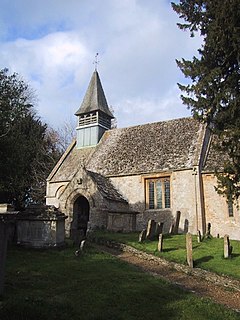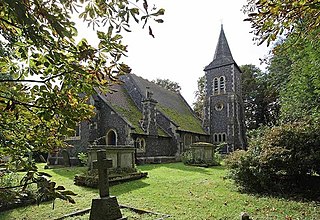| Middleton | |
|---|---|
 All Saints' Church, Middleton | |
Middleton shown within Essex | |
| OS grid reference | TL870395 |
| District | |
| Shire county | |
| Region | |
| Country | England |
| Sovereign state | United Kingdom |
| Post town | SUDBURY |
| Postcode district | CO10 |
| Police | Essex |
| Fire | Essex |
| Ambulance | East of England |
| EU Parliament | East of England |
Middleton is a village and civil parish in the Braintree District of Essex, England. The village is 1 mile (1.6 km) south from the Ballingdon suburb of the market town of Sudbury. The parish, which is 2 miles (3.2 km) east to west and less than 1 mile north to south, is bordered at the north and east by the county of Suffolk, at the west by the Essex parish of Bulmer and the A131 road, and at the south by the Essex parishes of Little Henny and Great Henny. The River Stour also forms the eastern border.

In England, a civil parish is a type of administrative parish used for local government, they are a territorial designation which is the lowest tier of local government below districts and counties, or their combined form, the unitary authority. Civil parishes can trace their origin to the ancient system of ecclesiastical parishes which historically played a role in both civil and ecclesiastical administration; civil and religious parishes were formally split into two types in the 19th century and are now entirely separate. The unit was devised and rolled out across England in the 1860s.

Braintree is a local government district in the English county of Essex, with a population of 147,084. Its main town is Braintree.

Essex is a county in the south-east of England, north-east of London. One of the home counties, it borders Suffolk and Cambridgeshire to the north, Hertfordshire to the west, Kent across the estuary of the River Thames to the south, and London to the south-west. The county town is Chelmsford, the only city in the county. For government statistical purposes Essex is placed in the East of England region.
In the north of the parish at Middleton Hall Farm is small light industrial and services park which includes a vehicle sales company and the headquarters of a turkey farm. This was the only farm and only trade listed in 1882 and 1914. By 1894 a carpenter was trading, and in 1902, a baker. The parish contained a mixed National School for 40 children, built in 1875. This had become a Public Elementary School by 1914. [1] Earlier, in 1818, the parish population of 90 had no school. [2]

A National school was a school founded in 19th century England and Wales by the National Society for Promoting Religious Education. These schools provided elementary education, in accordance with the teaching of the Church of England, to the children of the poor. Together with the less numerous British schools of the British and Foreign School Society, they provided the first near-universal system of elementary education in England and Wales.
Elementary schools were the first schools in England which were funded by taxation. They operated between 1870 and 1944 and provided an education for children between the ages of 5 and 14. In some areas older children were educated in separate 'Higher Elementary Schools', which were ruled un-permissible by the Cockerton Judgement 1899 and regularised by the 1902 Education Act. Many of these schools converted to Primary schools after 1944.
At the end of the 19th-century parish area varied from 868 acres (3.5 km2) to 890 acres (3.6 km2). Parish soil was of clay, loam and gravel, on which was grown wheat, barley, beans and turnips. Between 1881 and 1911, the population dropped from 165 to 133. [1]
The Parish Church of All Saints', which dates to the mid-12th century, is a Grade I listed building. Within the church chancel is a 14th-century Purbeck marble figurative floor slab to the memory of a rector of Middleton, died 1349. The parish register dates to 1700. The church seats 150. All Saints' Church was restored in the 19th century, when the bell turret and south porch were rebuilt, a vestry added to the north, and an organ chamber installed. The living at the time was a rectory with a residence and 40 acres (0.2 km2) of glebe – land used for the support of the parish priest and church. In 1882 an oil-on-canvas painting of the Annunciation was reported to be above All Saints' chancel arch, which might have been the work of the 16th-century artist Andrea Schiavone. The rectory house was noted between 1882 and 1902, but not in 1914, as "beautifully situated with a small park in front and contains a splendid collection of oil and water colour paintings by English, Dutch, Flemish, French and Italian masters". [1] [3] [4] [5]

A parish church in the Church of England is the church which acts as the religious centre for the people within the smallest and most basic Church of England administrative region, the parish – since the 19th century called the ecclesiastical parish to avoid confusion with the civil parish which many towns and villages have.

A listed building, or listed structure, is one that has been placed on one of the four statutory lists maintained by Historic England in England, Historic Environment Scotland in Scotland, Cadw in Wales, and the Northern Ireland Environment Agency in Northern Ireland.
A vestry was a committee for the local secular and ecclesiastical government for a parish in England and Wales, which originally met in the vestry or sacristy of the parish church, and consequently became known colloquially as the "vestry".
At the centre of Middleton Hall Farm is Middleton Hall, built in 1864 but today unlisted; it is part surrounded by a mutilated rectangular moat as a listed monument. [6]
A Grade II listed thatched two-storey cottage dating to the 17th century is 250 yards (229 m) southeast from the church on a minor road to Henny Street. [7] South from the church by 60 yards (55 m), and with access from Rectory Road is Queens Beeches, a Grade II listed early 19th-century grey brick house with attached stables and carriage house. [8]

Henny Street is a hamlet in the civil parish of Great Henny and the Braintree district of Essex, England. The hamlet is on Henny Road at the east of the parish and adjacent to the west bank of the River Stour.



















